Influence of Dolomite Rock Powder and Iron Tailings Powder on the Electrical Resistivity, Strength and Microstructure of Cement Pastes and Concrete
Abstract
:1. Introduction
2. Experimental Section
2.1. Raw Materials
2.2. Characterization Methods
2.2.1. Samples Preparation
2.2.2. Measurement of Electrical Resistivity
2.2.3. Measurement of Compressive Strength and Chloride Ion Permeability
2.2.4. Experiments of SEM and XRD
3. Results and Discussion
3.1. Electrical Resistivity
3.2. The Compressive Strength and Chloride Ion Permeability
3.3. SEM and XRD Analysis
4. Conclusions
- (1)
- The corrosion resistances of cement-based materials with different additives were determined by the electrical resistivity tests. The electrical resistivity of cement-based materials increases as a function of curing age, indicating the gradual solidification of free ions in cement over time. However, the electrical resistivity changes are highly sensitive to the chemical composition of additives.
- (2)
- The addition of ground granulated blast-furnace slag can improve the compressive strength of concrete, however, fly ash will play an opposite effect. Additionally, the compressive strength of concrete exhibits an increase and then decrease trend with the increase of dolomites and iron tailings.
- (3)
- The impermeability of chloride ions in concrete exhibits the first increase and then decrease trend with the increasing dosages of dolomite rock powder and iron tailings through the electric flux method.
- (4)
- The microstructure of cement pastes can be compacted when adding a small dosage of dolomites or iron tailings (less than 5%) due to the hydration promotion effect of additives. However, the microstructure of cement paste exhibits a deterioration with an excess content of dolomites or iron tailings, which is attributed to the internal defects of additives.
Author Contributions
Funding
Institutional Review Board Statement
Informed Consent Statement
Data Availability Statement
Conflicts of Interest
References
- He, B.; Gao, Y.; Qu, L.; Duan, K.; Zhou, W.; Pei, G. Characteristics analysis of self-luminescent cement-based composite materials with self-cleaning effect. J. Clean. Prod. 2019, 225, 1169–1183. [Google Scholar] [CrossRef]
- Mo, Z.; Gao, X.; Su, A. Mechanical performances and microstructures of metakaolin contained UHPC matrix under steam curing conditions. Constr. Build. Mater. 2021, 268, 121112. [Google Scholar] [CrossRef]
- Chen, L.; Wang, Y.; Wang, L.; Zhang, Y.; Li, J.; Tong, L.; Hu, Q.; Dai, J.; Tsang, C.W. Stabilisation/solidification of municipal solid waste incineration fly ash by phosphate-enhanced calcium aluminate cement. J. Hazard. Mater. 2021, 408, 124404. [Google Scholar] [CrossRef]
- Avila-López, U.; Almanza-Robles, J.M.; Escalante-García, J. Investigation of novel waste glass and limestone binders using statistical methods. Constr. Build. Mater. 2015, 82, 296–303. [Google Scholar] [CrossRef]
- Vishwakarma, V.; Ramachandran, D. Green Concrete mix using solid waste and nanoparticles as alternatives—A review. Constr. Build. Mater. 2018, 162, 96–103. [Google Scholar] [CrossRef]
- Wang, L.; Luo, R.; Zhang, W.; Jin, M.; Tang, S. Effects of fineness and content of phosphorus slag on cement hydration, permeability, pore structure and fractal dimension of concrete. Fractals 2021, 29, 2140004. [Google Scholar] [CrossRef]
- Ren, J.; Hu, L.; Dong, Z.; Tang, L.; Xing, F.; Liu, J. Effect of silica fume on the mechanical property and hydration characteristic of alkali-activated municipal solid waste incinerator (MSWI) fly ash. J. Clean. Prod. 2021, 295, 126317. [Google Scholar] [CrossRef]
- Rehman, A.; Lee, S.; Kim, J. Use of municipal solid waste incineration ash in 3D printable concrete. Process Saf. Environ. Prot. 2020, 142, 219–228. [Google Scholar] [CrossRef]
- Wang, L.; Guo, F.; Yang, H.; Wang, Y.; Tang, S. Comparison of fly ash, PVA fiber, MgO and shrinkage-reducing admixture on the frost resistance of face slab concrete via pore structural and fractal analysis. Fractals 2021, 29, 2140002. [Google Scholar] [CrossRef]
- Papatzani, S.; Grammatikos, S.; Paine, K. Permeable Nanomontmorillonite and Fibre Reinforced Cementitious Binders. Materials 2019, 12, 3245. [Google Scholar] [CrossRef] [PubMed] [Green Version]
- Papatzani, S.; Paine, K. A Step by Step Methodology for Building Sustainable Cementitious Matrices. Appl. Sci. 2020, 10, 2955. [Google Scholar] [CrossRef]
- Alderete, N.M.; Joseph, A.M.; Heede, P.; Matthys, S.; Belie, N.D. Effective and sustainable use of municipal solid waste incineration bottom ash in concrete regarding strength and durability. Resour. Conserv. Recycl. 2021, 167, 105356. [Google Scholar] [CrossRef]
- Wang, H.; Hu, L.; Cao, P.; Luo, B.; Tang, J.; Shi, F.; Yu, J.; Li, H.; Jin, K. The application of electrical parameters to reflect the hydration process of cement paste with rice husk ash. Materials 2019, 12, 2815. [Google Scholar] [CrossRef] [PubMed] [Green Version]
- Yang, C.; Cui, C.; Qin, J.; Cui, X. Characteristics of the fired bricks with low-silicon iron tailings. Constr. Build. Mater. 2014, 70, 36–42. [Google Scholar] [CrossRef]
- Yao, G.; Wang, Q.; Wang, Z.; Wang, J.; Lyu, X. Activation of hydration properties of iron ore tailings and their application as supplementary cementitious materials in cement. Powder Technol. 2020, 360, 863–871. [Google Scholar] [CrossRef]
- Ding, Y.; An, P.; Cao, M. Study on Utilization of Waste Slate Powder as Mineral Admixture for Cement. J. Build. Mater. 2010, 13, 62–65. [Google Scholar]
- Ye, G.; Liu, X.; Schutter, G.D.; Poppe, A.M.; Taerwe, T. Influence of limestone powder used as filler in SCC on hydration and microstructure of cement pastes. Cem. Concr. Compos. 2007, 29, 94–102. [Google Scholar] [CrossRef]
- Han, F.; Song, S.; Liu, J.; Huang, S. Properties of steam-cured precast concrete containing iron tailing powder. Powder Technol. 2019, 345, 292–299. [Google Scholar] [CrossRef]
- Han, F.; Luo, A.; Liu, J.; Zhang, Z. Properties of high-volume iron tailing powder concrete under different curing conditions. Constr. Build. Mater. 2020, 241, 118108. [Google Scholar] [CrossRef]
- Lu, D.; Zhong, J.; Yan, B.; Gong, J.; He, Z.; Zhang, G.; Song, C. Effects of Curing Conditions on the MECHANICAL and Microstructural Properties of Ultra-High-Performance Concrete (UHPC) Incorporating Iron Tailing. Powder Technol. 2021, 14, 215. [Google Scholar] [CrossRef]
- Song, S.; Zhang, L.; Li, Z. Effect of iron tailings micropow der on late-property of concrete. Concrete 2019, 128, 131–145. (In Chinese) [Google Scholar]
- Wang, H.; Zhang, A.; Zhang, L.; Liu, J.; Han, Y.; Shu, H.; Wang, J. Study on the influence of compound rust inhibitor on corrosion of steel bars in chloride concrete by electrical parameters. Constr. Build. Mater. 2020, 262, 120763. [Google Scholar] [CrossRef]
- Shi, W.; Wang, T.-Z.; Dong, Z.-H.; Guo, X.-P. Application of wire beam electrode technique to investigate the migrating behavior of corrosion inhibitors in mortar. Constr. Build. Mater. 2017, 134, 167–175. [Google Scholar] [CrossRef]
- Ahmet, R.; Topcu, I.B. Influence of fly ash on corrosion resistance and chloride ion permeability of concrete. Constr. Build. Mater. 2012, 31, 258–264. [Google Scholar]
- Shi, X.; Ning, X.; Fortune, K.; Jing, G. Durability of steel reinforced concrete in chloride environments: An overview. Constr. Build. Mater. 2012, 30, 125–138. [Google Scholar] [CrossRef]
- GB/T 3048.2-2007; Test Methods for Electrical Properties of Electric Cables and Wires. China Standard Press: Beijing, China, 2007. (In Chinese)
- GB/T 50081-2019; Standard for Test Methods of Physical and Mechanical Properties of Concrete. China Standard Press: Beijing, China, 2019. (In Chinese)
- GB/T 50082-2009; Standard for Test Method of Long-Term Performance and Durability of Ordinary Concrete. China Standard Press: Beijing, China, 2009. (In Chinese)
- Wang, H.; Jin, K.; Zhang, A.; Zhang, L.; Feng, L. External erosion of sodium chloride on the degradation of self-sensing and mechanical properties of aligned stainless steel fiber reinforced reactive powder concrete. Constr. Build. Mater. 2021, 287, 123028. [Google Scholar] [CrossRef]
- Cui, L.; Wang, H. Research on the Mechanical Strengths and the Following Corrosion Resistance of Inner Steel Bars of RPC with Rice Husk Ash and Waste Fly Ash. Coatings 2021, 11, 1480. [Google Scholar] [CrossRef]
- Wang, H.; Zhang, A.; Zhang, L.; Wang, Q.; Han, Y.; Liu, J.; Gao, X.; Shi, F.; Lin, X.; Feng, L. Hydration process of rice husk ash cement paste and its corrosion resistance of embedded steel bar. J. Cent. South Univ. 2020, 27, 11. [Google Scholar] [CrossRef]
- Wang, H.; Gao, X.; Liu, J. Effects of salt freeze-thaw cycles and cyclic loading on the piezoresistive properties of carbon nanofibers mortar. Constr. Build. Mater. 2018, 177, 192–201. [Google Scholar] [CrossRef]
- Layssi, H.; Ghods, P.; Alizadeh, A.R.; Salehi, M. Electrical Resistivity of Concrete. Concr. Int. 2015, 37, 41–46. [Google Scholar]
- Cui, L.; Wang, H. Influence of Waste Fly Ash on the Rheological Properties of Fresh Cement Paste and the Following Electrical Performances and Mechanical Strengths of Hardened Specimens. Coatings 2021, 11, 1558. [Google Scholar] [CrossRef]
- Kurda, R.; Brito, J.; Silvestre, J.D. Water absorption and electrical resistivity of concrete with recycled concrete aggregates and fly ash. Cem. Concr. Compos. 2018, 95, 169–182. [Google Scholar] [CrossRef]
- Xue, J.; Wang, X.; Wang, Z.; Xu, S.; Liu, H. Investigations on influencing factors of resistivity measurement for graphite tailings concrete. Cem. Concr. Compos. 2021, 123, 104206. [Google Scholar] [CrossRef]
- Nguyen, T.; Chatchawan, R.; Saengsoy, W.; Tangtermsirikul, S.; Sugiyama, T. Influences of different types of fly ash and confinement on performances of expansive mortars and concretes. Constr. Build. Mater. 2019, 209, 176–186. [Google Scholar] [CrossRef]
- Zheng, J.; Liu, G. The Influence and Application of Slag, Fly Ash, and Limestone Flour on Compressive Strength of Concrete Based on the Concrete Compressive Strength Development Over Time (CCSDOT) Model. Appl. Sci. 2020, 10, 3572. [Google Scholar] [CrossRef]
- Wu, M.; Sui, S.; Zhang, Y.; Jia, Y.; She, W.; Liu, Z.; Yang, Y. Analyzing the filler and activity effect of fly ash and slag on the early hydration of blended cement based on calorimetric test—Sciencedirect. Constr. Build. Mater. 2021, 276, 122201. [Google Scholar] [CrossRef]
- Lu, C.; Ge, X.; Mei, G.; Liu, W.; Wang, H.; Yang, H. Study on hydration characteristics of dolomite powder in composite cementitious system. Concrete 2013, 11, 65–67. (In Chinese) [Google Scholar]
- Li, T.; Wang, S.; Xu, F.; Meng, X.; Zhan, M. Study of the basic mechanical properties and degradation mechanism of recycled concrete with tailings before and after carbonation. J. Clean. Prod. 2020, 259, 120923. [Google Scholar] [CrossRef]
- Cheng, Y.; Huang, F.; Li, W.; Liu, R.; Li, G.; Wei, J. Test research on the effects of mechanochemically activated iron tailings on the compressive strength of concrete. Constr. Build. Mater. 2016, 118, 164–170. [Google Scholar] [CrossRef]
- Yazici, H. The effect of curing conditions on compressive strength of ultra high strength concrete with high volume mineral admixtures. Build. Environ. 2007, 42, 2083–2089. [Google Scholar] [CrossRef]
- Wee, T.H.; Matsunaga, Y.; Watanabe, Y.; Sakai, E. Microstructure and strength properties of high strength concretes containing various mineral admixtures. Cem. Concr. Res. 1995, 25, 709–714. [Google Scholar] [CrossRef]
- Thomas, M.; Bamforth, P.B. Modelling chloride diffusion in concrete: Effect of fly ash and slag. Cem. Concr. Res. 1999, 29, 487–495. [Google Scholar] [CrossRef]
- Li, B.; Yi, L.; Feng, Z.; Fan, L.; Ye, X. Study on the effects of rock dust content on the durability of C60 mar ufactured sand marine concrete. Concrete 2017, 10, 169–173. (In Chinese) [Google Scholar]
- Wu, R.; Shen, Y.; Liu, J.; Cheng, L.; Zhang, Y. Effect of Iron Tailings and Slag Powders on Workability and Mechanical Properties of Concrete. Front. Mater. 2021, 8, 723119. [Google Scholar]
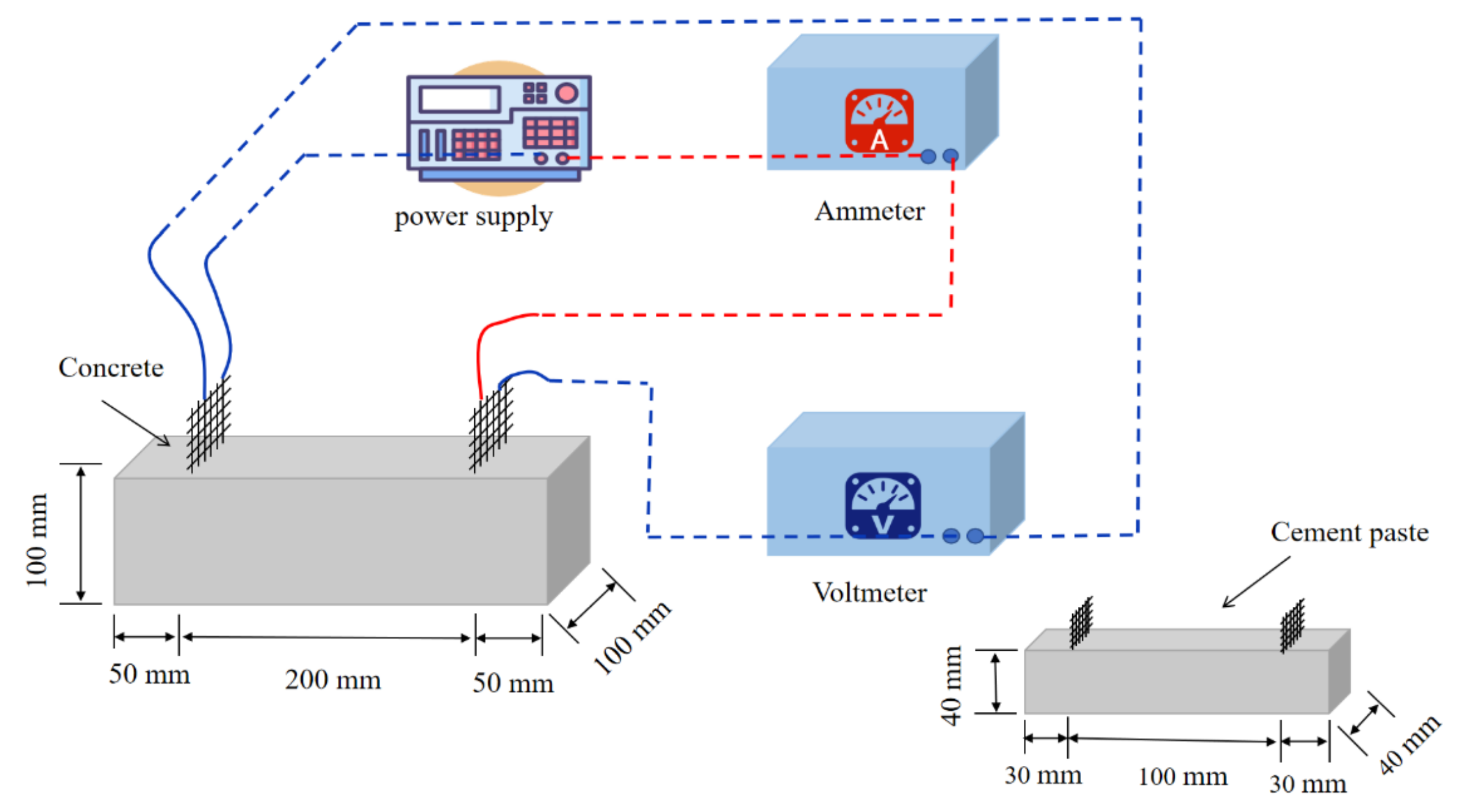


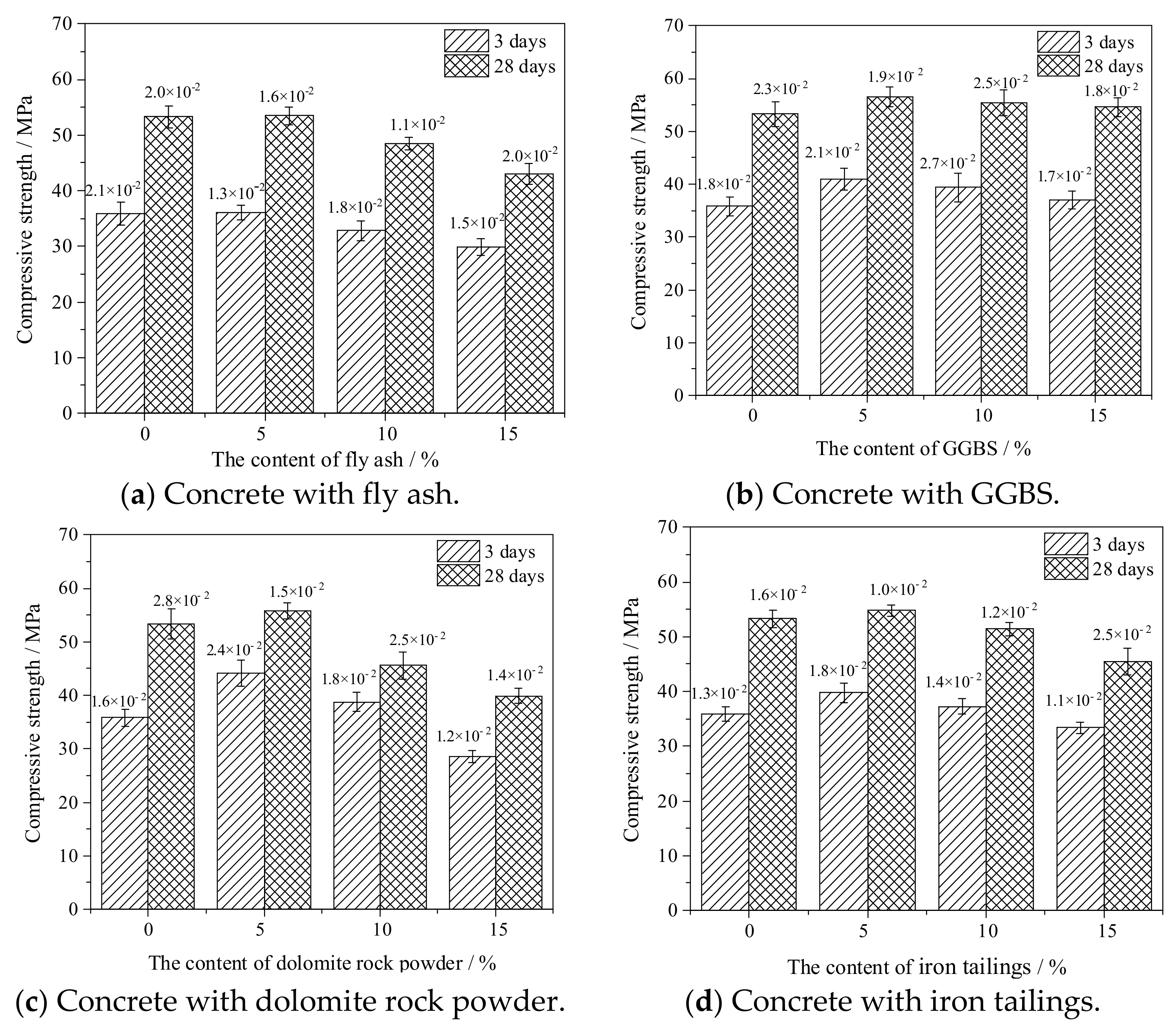

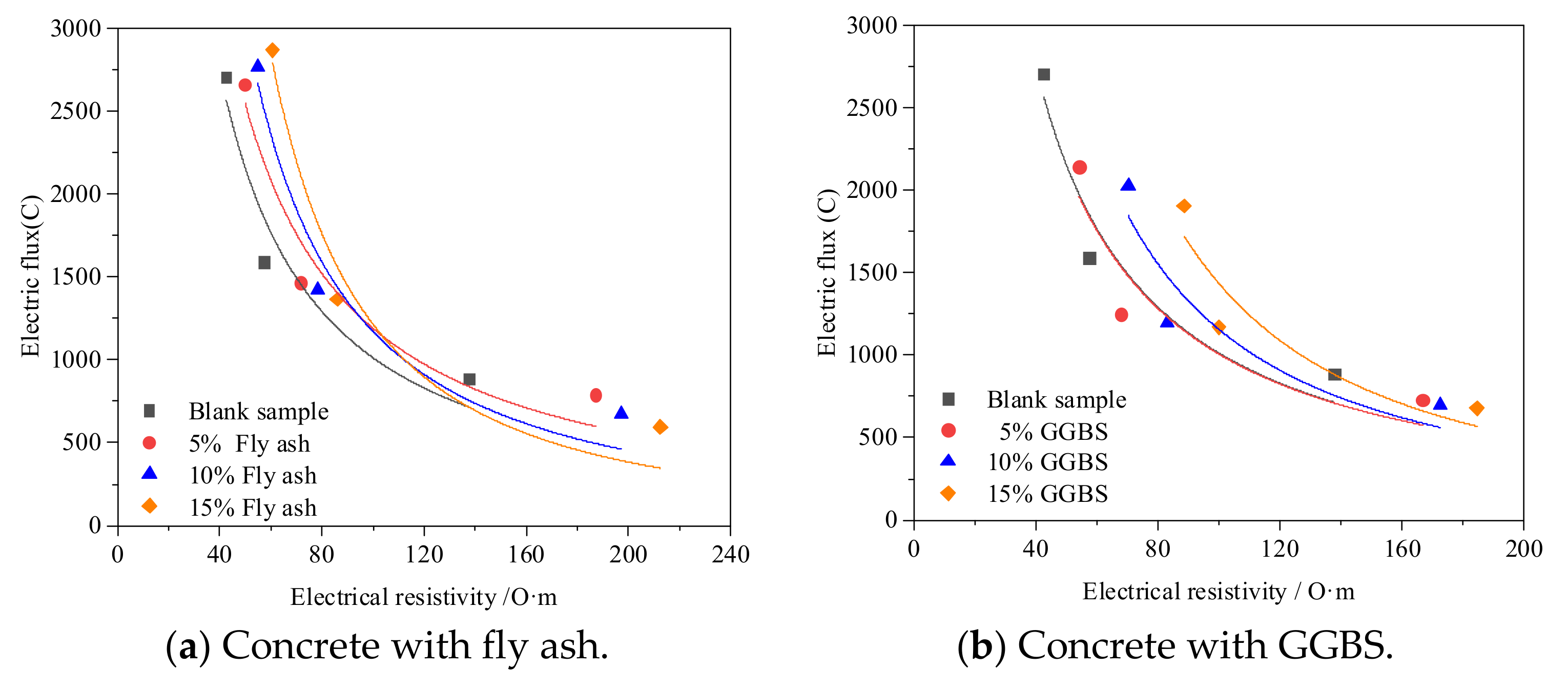

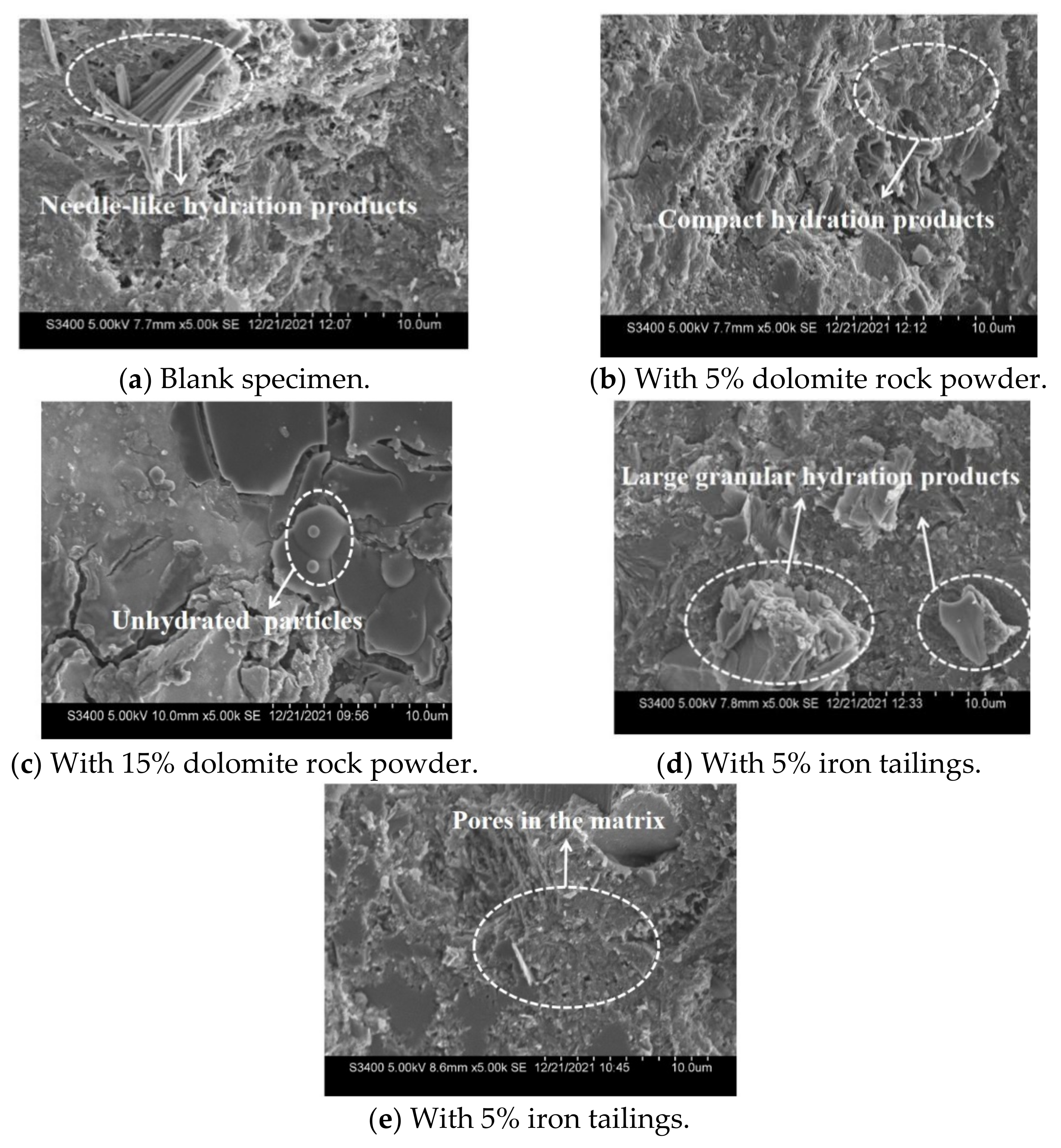
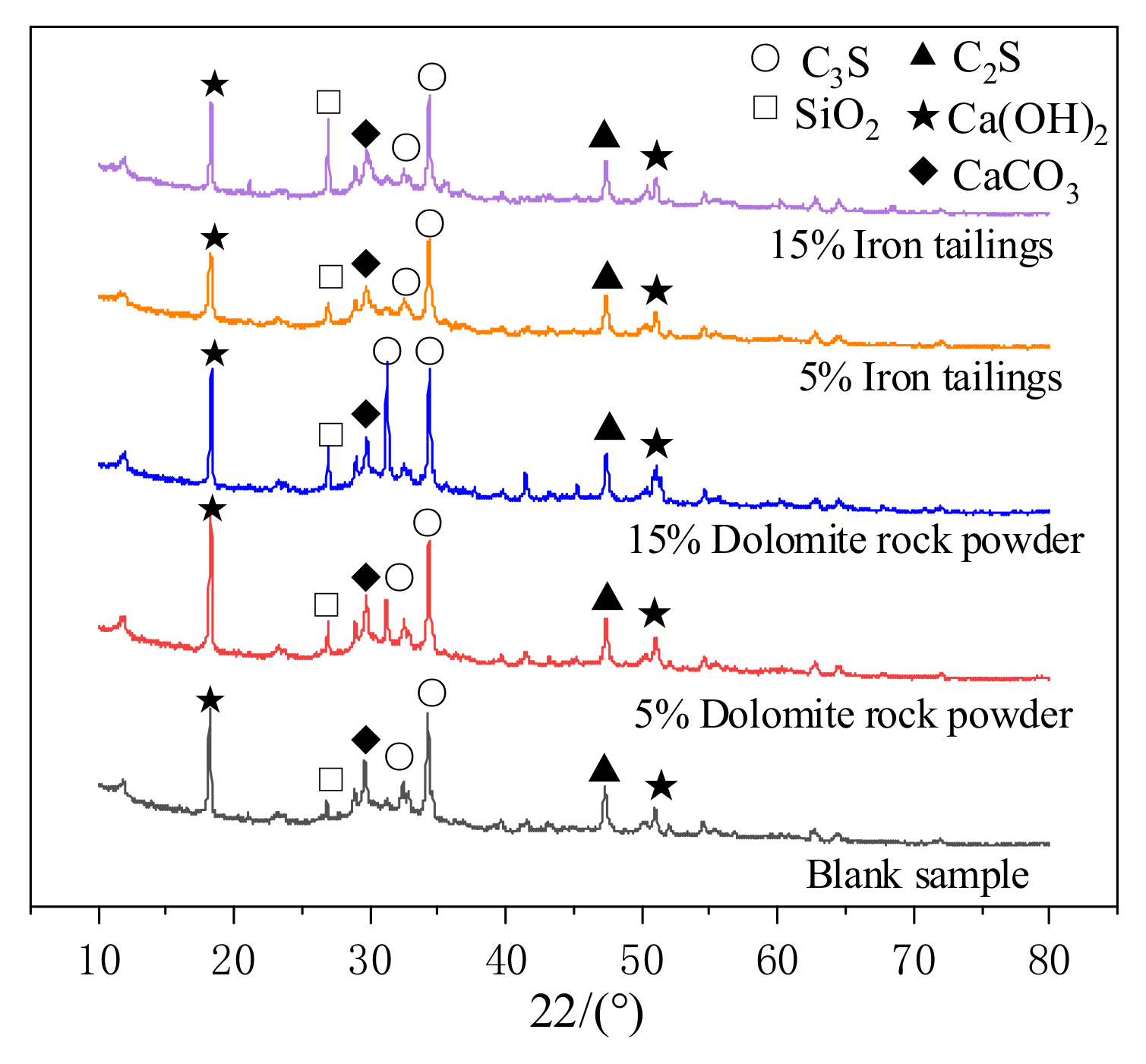
| Types | Particle Size/μm | |||||||
|---|---|---|---|---|---|---|---|---|
| 0.3 | 0.6 | 1 | 4 | 8 | 64 | 360 | 580 | |
| Cement | 0.1 | 1.35 | 3.68 | 23.79 | 39.46 | 94.12 | 100 | 100 |
| Fly ash | 0.49 | 1.54 | 2.93 | 19.54 | 37.9 | 92.99 | 100 | 100 |
| GGBS | 0.31 | 1.78 | 4.2 | 21.85 | 38.68 | 100 | 100 | 100 |
| Dolomite | 0 | 0.58 | 1.45 | 7.14 | 13.01 | 75.91 | 97.41 | 100 |
| Iron tailings | 0.21 | 2.28 | 6.55 | 32.22 | 47.91 | 100 | 100 | 100 |
| Types | CaO | SiO2 | Al2O3 | Fe2O3 | MgO | SO3 | K2O | MnO | Loss |
|---|---|---|---|---|---|---|---|---|---|
| Cement | 4.55 | 50.23 | 33.22 | 5.95 | 0.79 | 0.91 | 1.48 | / | 2.81 |
| Fly ash | 4.55 | 50.23 | 33.22 | 5.95 | 0.79 | 0.91 | 1.48 | / | 2.81 |
| GGBS | 42.19 | 27.56 | 15.80 | 0.31 | 7.52 | 2.89 | 0.45 | / | 1.89 |
| Dolomite | 48.62 | 29.67 | 0.72 | 0.47 | 20.17 | 0.05 | 0.18 | / | 0.07 |
| Iron tailings | 14.78 | 47.35 | 5.05 | 23.56 | 1.55 | 2.04 | / | 3.21 | 2.46 |
| Cement | Fine Aggregate | Coarse Aggregate | Fly Ash | GGBS | Dolomites | Iron Tailings | Water |
|---|---|---|---|---|---|---|---|
| 457 | - | - | - | - | - | - | 146 |
| 434.2 | - | - | 22.8 | - | - | - | 146 |
| 411.3 | - | - | 45.7 | - | - | - | 146 |
| 388.5 | - | - | 68.5 | - | - | - | 146 |
| 434.2 | - | - | - | 22.8 | - | - | 146 |
| 411.3 | - | - | - | 45.7 | - | - | 146 |
| 388.5 | - | - | - | 68.5 | - | - | 146 |
| 434.2 | - | - | - | - | 22.8 | - | 146 |
| 411.3 | - | - | - | - | 45.7 | - | 146 |
| 388.5 | - | - | - | - | 68.5 | - | 146 |
| 434.2 | - | - | - | - | - | 22.8 | 146 |
| 411.3 | - | - | - | - | - | 45.7 | 146 |
| 388.5 | - | - | - | - | - | 68.5 | 146 |
| 457 | 753 | 1080 | - | - | - | - | 160 |
| 434.2 | 753 | 1080 | 22.8 | - | - | - | 160 |
| 411.3 | 753 | 1080 | 45.7 | - | - | - | 160 |
| 388.5 | 753 | 1080 | 68.5 | - | - | - | 160 |
| 434.2 | 753 | 1080 | - | 22.8 | - | - | 160 |
| 411.3 | 753 | 1080 | - | 45.7 | - | - | 160 |
| 388.5 | 753 | 1080 | - | 68.5 | - | - | 160 |
| 434.2 | 753 | 1080 | - | - | 22.8 | - | 160 |
| 411.3 | 753 | 1080 | - | - | 45.7 | - | 160 |
| 388.5 | 753 | 1080 | - | - | 68.5 | - | 160 |
| 434.2 | 753 | 1080 | - | - | - | 22.8 | 160 |
| 411.3 | 753 | 1080 | - | - | - | 45.7 | 160 |
| 388.5 | 753 | 1080 | - | - | - | 68.5 | 160 |
| Mineral Admixtures | Types | Content/% | a | b | c | R2 |
|---|---|---|---|---|---|---|
| Fly ash | Cement paste | 0 | −2.6 × 10−4 | 0.14 | 8.78 | 0.968 |
| 5 | −3.0 × 10−5 | 0.22 | 7.73 | 0.998 | ||
| 10 | 3.0 × 10−5 | 0.24 | 7.52 | 0.999 | ||
| 15 | 5.0 × 10−5 | 0.27 | 7.31 | 0.998 | ||
| Concrete | 0 | −5.3 × 10−4 | 0.64 | 26.27 | 0.997 | |
| 5 | −1.0 × 10−4 | 0.99 | 24.13 | 0.998 | ||
| 10 | −2.1 × 10−4 | 1.27 | 21.81 | 0.999 | ||
| 15 | −2.7 × 10−3 | 1.49 | 20.28 | 0.999 | ||
| Slag | Cement paste | 0 | −2.6 × 10−4 | 0.14 | 8.78 | 0.968 |
| 5 | −6.0 × 10−4 | 0.24 | 9.87 | 0.911 | ||
| 10 | −9.4 × 10−4 | 0.31 | 10.75 | 0.869 | ||
| 15 | −1.0 × 10−3 | 0.35 | 11.63 | 0.860 | ||
| Concrete | 0 | −5.3 × 10−4 | 0.64 | 26.27 | 0.997 | |
| 5 | 6.3 × 10−4 | 0.48 | 31.03 | 0.981 | ||
| 10 | −1.5 × 10−4 | 0.94 | 33.03 | 0.967 | ||
| 15 | −3.0 × 10−3 | 1.35 | 34.46 | 0.938 | ||
| Dolomite rock powder | Cement paste | 0 | −2.6 × 10−4 | 0.14 | 8.78 | 0.968 |
| 5 | −1.1 × 10−4 | 0.11 | 8.02 | 0.973 | ||
| 10 | −1.5 × 10−4 | 0.11 | 7.80 | 0.981 | ||
| 15 | −2.1 × 10−4 | 0.12 | 7.68 | 0.987 | ||
| Concrete | 0 | −5.3 × 10−4 | 0.64 | 26.27 | 0.997 | |
| 5 | −5.2 × 10−3 | 1.57 | 31.57 | 0.925 | ||
| 10 | −4.5 × 10−3 | 1.42 | 27.06 | 0.939 | ||
| 15 | −2.7 × 10−3 | 0.99 | 38.15 | 0.953 | ||
| Iron tailings | Cement paste | 0 | −2.6 × 10−4 | 0.14 | 8.78 | 0.968 |
| 5 | −1.5 × 10−4 | 0.09 | 8.45 | 0.973 | ||
| 10 | −3.9 × 10−4 | 0.14 | 6.91 | 0.992 | ||
| 15 | −2.9 × 10−4 | 0.12 | 6.31 | 0.985 | ||
| Concrete | 0 | −5.3 × 10−4 | 0.64 | 26.27 | 0.997 | |
| 5 | −3.0 × 10−3 | 1.03 | 37.61 | 0.943 | ||
| 10 | −2.2 × 10−3 | 0.86 | 34.69 | 0.965 | ||
| 15 | −2.0 × 10−3 | 0.79 | 29.16 | 0.972 |
| Types | M/% | a | b | R2 |
|---|---|---|---|---|
| Fly ash | 0 | 1.5 × 105 | −1.09 | 0.931 |
| 5 | 1.8 × 105 | −1.09 | 0.939 | |
| 10 | 6.5 × 105 | −1.37 | 0.956 | |
| 15 | 2.6 × 106 | −1.67 | 0.960 | |
| GGBS | 0 | 1.5 × 105 | −1.09 | 0.931 |
| 5 | 1.5 × 105 | −1.08 | 0.867 | |
| 10 | 5.1 × 105 | −1.32 | 0.859 | |
| 15 | 1.52 × 105 | −1.51 | 0.847 | |
| Dolomite rock powder | 0 | 1.5 × 105 | −1.09 | 0.931 |
| 5 | 6.7 × 106 | −1.87 | 0.862 | |
| 10 | 1.04 × 105 | −1.42 | 0.900 | |
| 15 | 1.7 × 105 | −1.01 | 0.999 | |
| Iron tailings | 0 | 1.5 × 105 | −1.09 | 0.931 |
| 5 | 7.0 × 106 | −1.87 | 0.900 | |
| 10 | 1.8 × 106 | −1.59 | 0.960 | |
| 15 | 6.6 × 105 | −1.39 | 0.930 |
Publisher’s Note: MDPI stays neutral with regard to jurisdictional claims in published maps and institutional affiliations. |
© 2022 by the authors. Licensee MDPI, Basel, Switzerland. This article is an open access article distributed under the terms and conditions of the Creative Commons Attribution (CC BY) license (https://creativecommons.org/licenses/by/4.0/).
Share and Cite
Liu, Y.; Hao, W.; He, W.; Meng, X.; Shen, Y.; Du, T.; Wang, H. Influence of Dolomite Rock Powder and Iron Tailings Powder on the Electrical Resistivity, Strength and Microstructure of Cement Pastes and Concrete. Coatings 2022, 12, 95. https://doi.org/10.3390/coatings12010095
Liu Y, Hao W, He W, Meng X, Shen Y, Du T, Wang H. Influence of Dolomite Rock Powder and Iron Tailings Powder on the Electrical Resistivity, Strength and Microstructure of Cement Pastes and Concrete. Coatings. 2022; 12(1):95. https://doi.org/10.3390/coatings12010095
Chicago/Turabian StyleLiu, Yang, Wenru Hao, Wei He, Xia Meng, Yinlan Shen, Tao Du, and Hui Wang. 2022. "Influence of Dolomite Rock Powder and Iron Tailings Powder on the Electrical Resistivity, Strength and Microstructure of Cement Pastes and Concrete" Coatings 12, no. 1: 95. https://doi.org/10.3390/coatings12010095





